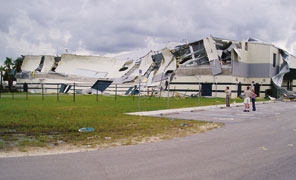...wind loads, the wind velocity used in structural calculation was to be 140 mph in Broward County and 146 mph in Miami-Dade County. Statewide, hospitals built after 1997 had to meet the Miami-Dade County standards.
 |
 |
| COLLAPSED Although built only two years ago, a civic center serving as a shelter succumbed to the hurricane, forcing refugees to flee. (Photo top courtesy of Forrest Masters; bottom courtesy of Tim Reinhold) |
Shelter Lost
The Turner Agri-Civic Center in Arcadia, a two-year-old, 3,600-sq-ft building, serving as a shelter for 1,400 people, was designed for 140 mph winds, but collapsed in estimated 100 to 110 mph winds. A sheriffs deputy who was there said the windward corner of the roof began to separate first, and the building partially collapsed progressively along its length. The refugees were able to escape. One investigator who met with county commissioners describes them as furious. "They spent $8 million on the facility, and $2 million of that was an upgrade" to make it a hurricane shelter, he said.
It is clearly going to take a lot of investigation, Reinhold says. We'll be looking at the connection details [to] see if there was a reasonable amount of reinforcing. He said the building had a 1.5-story masonry band, with several cast-in-place bond beams, metal cladding and a sloped roof. The wind came on the gable end, and something gave way that shouldnt have given way at all. He says he only saw evidence of straight-line winds in the vicinity, and estimates put the wind speed at 100 to 110 mph.
Reinhold, who was on a preliminary survey team, says investigations will continue. "Well be looking at the connection details and looking to see if there was a reasonable amount of reinforcing." He says the building had 11Ú2-stories of masonry with cast-in-place concrete beams, metal cladding and a sloped roof.
I would hope, with these higher winds coming up through the inland part of the state, they will realize Florida really shouldn't be moving backward with our standards, adds Reinhold. He says the higher wind threshold in the code being considered was set with nationwide conditions in mind, since in most parts of the U.S., winds are mostly associated with short-lived storms. But Florida, with its history of prolonged winds and hurricanes, needs more stringent standards for tie-downs and connectors. He adds that, in his research, he got a chance to tear a bunch of houses apart, to test their weak points and strengths. He says conventional connections only engage 20% of the strength you have already paid for and put into the house, and that with just a little more attention into the connections, houses could be substantially strengthened.
|
Reinhold says a lot of new construction designed and built to the new standards did well, but that there are still issues, even with some of the newer provisions of the codesuch as where tile roofs are required. In a lot of homes at the higher end, ordinances required them to have tile roofs, and the tiles were coming off and spraying through the neighborhoods. They were creating real problems for the houses downstream, he says. There will be some interesting reports coming in down the road from that kind of stuff.
Although even mobile homes built to the new standards performed well, many had porches, sunrooms and storage shed additions that did not, because they were not built to the same wind standards. They were having serious problems, Reinhold says. Almost everyone had them, and they had huge amounts of aluminum flowing through those manufactured home parks. Just huge debris fields.
Strong-Tie's Shackelford says there are several building code windspeed zones in Florida, ranging from 150 mph in the Keys to 146 mph in Dade County, and down to 90 mph zones in central and northern parts of the state. Under the code now in effect, commercial and residential structures built in wind zones above 100 mph require roof tie-downs and engineered wind protection systems. However, he says, the Florida Building Commission will meet in Miami at the end of the month to consider adoption of a new standard, the International Residential Code. One of its provisions shifts the cut-off for tie-down requirements from 100 mph to 110 mph.
"Anything [in a zone for] less than 110 mph is supposed to be able to use the prescriptive standards. Anything over 110 mph will have to use an engineer or high-wind manuals," he says. One effect of that provision, according to the IBHS, is that a large portion of Florida residential construction would be suddenly relieved of the tie-down requirements. The IBHS in June sent state regulators a strong letter urging that the provision be changed back to 100 mph before the new code adoption.
Shackelford predicts the damage from Hurricane Charley, which cut a diagonal swath of destruction through the state from coast to coast, may convince regulators to make the change because "there is going to be such a groundswell of support.
Steve Halverson, president of The Haskell Co., Jacksonville, Fla., says several school projects under construction were damaged. "Our first priority is to take care of...

Post a comment to this article
Report Abusive Comment